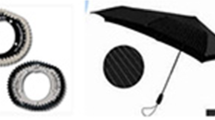Abstract
This chapter proposes an approach to extract and manage knowledge from patent documents for use by design engineers within the framework of the inventive design method (IDM). IDM is an extension of TRIZ, the theory of inventive problem solving, and is meant for complex situations. It uses generic linguistic markers to locate and extract IDM-related knowledge, such as problems, partial solutions, and parameters, to automatically populate IDM ontology.
Access this chapter
Tax calculation will be finalised at checkout
Purchases are for personal use only
Preview
Unable to display preview. Download preview PDF.
Similar content being viewed by others
References
Altshuller GS (1998) 40 principles: TRIZ keys to technical innovation. In: Lev Shulyak et Steven Rodman (trans). Technical Innovation Center, INC, Worcester, MA, p 141 (1ère édition 1998). ISBN-10:0964074036
Altshuller GS (2004) Et soudain apparut l’inventeur: Les idées de TRIZ. In: Seredinski (ed) Paris, p 166 (The art of inventing – and suddenly the inventor appeared. Detskays Literatura, Moscow, 1ère édition, 1984). ISBN-10:2952139415
Bereau P, Dou H (1997) La classification neuronale pour la détection de nouvelles tendances de recherche et le développement de nouveaux produits. CIFRE/CRRM, Université d’Aix-Marseille, p 17
Blossier JE (2002) Guide d’initiation à TRIZ. PSA Peugeot Citroën, p 85. Available via http://crrm.u-3mrs.fr/sfba/ile-rousse/1997/article1.pdf
Bultey A, Bertrand De Beuvron F, Rousselot F (2007) A substance-field ontology to support the TRIZ thinking approach. IJCAT 30(1):113–124
Cascini G, Russo D (2007) Computer-aided analysis of patents and search for TRIZ contradictions. Int J Prod Dev Spec Issue Creat Innov Employ TRIZ 4(1):52–67
Cavallucci D, Guiot R (2008) Engager les activités de conception dans des voies inventives pertinentes : l’apport de la TRIZ. Systèmes techniques, lois d’évolution et méthodes de conception. Hermès, p 20
Cavallucci D, Khomenko N (2007) From TRIZ to OTSM-TRIZ: addressing complexity challenges in inventive design. Int J Prod Dev 4(1/2):4–21
Cavallucci D, Rousselot F, Zanni-Merk C (2008) Representing and selecting problems in contradiction networks. 2ème session de l’IFIP sur l’innovation assistée par ordinateur
Cavallucci D, Rousselot F, Zanni C (2010) Initial situation analysis through problem graph. CIRP J Manuf Sci Technol 2(4):310–317
Dubois S et al (2004) Modélisation des concepts de formulation des problèmes de la TRIZ. Actes des 5èmes journées francophones d’Ingénierie des Connaissances, IC’2004, Lyon
Feldman R, Fresko M, Hirsh H, Aumann Y, Liphstat O, Schler Y, Rajman M (1998) Knowledge management: a text mining approach. In: PAKM, vol 98, p 9
Ghiglione R, Kekenbosch C, Landré A (1995) L’analyse cognitivo-discursive. Presses universitaires de Grenoble
Ghoula N, Khelif K, Dieng-kuntz R (2007) Supporting patent mining by using ontology-based semantic annotations. In: Proceedings of la conférence internationale sur le Web intelligence IEEE/WIC/ACM, pp 435–438
Guiraud P (1969) Français populaire ou français relâché. Le français dans le monde 69:23–27
Guyot B, Normand S (2004) Le document brevet, un passage entre plusieurs mondes. Paris, p 22
Hansen MM (1997) Alors et donc in spoken French: a reanalysis. J Pragmat 28:153–187
Hearst M (1992) Automatic acquisition of hyponyms from large text corpus. In: Proceedings of the 14th conference on computational linguistics, vol 2. Association for Computational Linguistics, pp 539–545
Hernandez N, Grau B (2003) Topic and meta-descriptor extraction for text description. In: Proceeding of web intelligence conference (WIC 03), IEEE conference, Halifax, Canada
Hoey M (1991) Patterns of Lexis in text (Describing English language). Oxford University Press, Oxford
Kerem D (2009) L’analyse des textes de brevet – Extraction de reconnaissances utile à la “conception inventive” à partir de textes de brevet. Master’s thesis, University of Strasbourg
Lebart L, Salem A (1992) Statistique textuelle. Dunod
Legallois D, Cellier P, Charnois T (2011) Calcul de réseaux phrastiques pour l’analyse et la navigation textuelle. In: 18e conférence sur le Traitement Automatique des Langues Naturelles (TALN 2011), 6 p
Osenga K (2006) Linguistics and patent claim construction. Rutgers Univ Law J 38:61–108
Pierard S, Bestgen Y (2006) Validation d’une méthodologie pour l’étude de marqueurs de la segmentation dans un grand corpus de textes. Natur Lang Process 47(2):89–110
Rousselot F, Zanni C, Cavallucci D (2007) Une ontologie pour l’acquisition et l’exploitation des connaissances pour la conception inventive. Revue des Nouvelles technologies de l’information, numéro spécial sur la modélisation des connaissances
Savransky S (2000) Engineering of creativity: introduction to Triz methodology of inventive problem solving. Boca Raton
Schone P, Jurafsky D (2001) Knowledge-free induction of inflectional morphologies. In: Proceedings of the North American chapter of the Association for Computational Linguistics (NAACL-2001)
Shannon CE (1948) A mathematical theory of communication. Bell Syst Tech J 27(3):379–423
Souili A, Cavallucci D, Rousselot F (2013) A lexico-syntactic pattern matching method to extract IDM-TRIZ knowledge from on-line patent databases. Proc Eng 131:418–425 (2015)
Souili A, Cavallucci D, Rousselot F, Zanni C (2011) Starting from patent to find inputs to the problem graph model of IDM-TRIZ. In: TRIZ future conference 2011, Dublin, Ireland
Teufel S (1998) Metadiscourse markers and problem-structuring in scientific articles. In: Stede M, Wanner L, Eduard Hovy (eds) Proceedings of the workshop on discourse relations and discourse markers, 17th International conference on computational linguistics. Montreal, Canada, 15 August, pp 43–49
Trippe AJ (2003) Patinformatics: tasks to tools. World Patent Inf 25(3):211–221
Yan W (2014) Modélisation de (Méta) connaissances pour la Conception Inventive. PhD thesis, University of Strasbourg, France
Yeap T, Loo GH, Pang S (2003) Computational patent mapping: intelligent agents for nanotechnology. In: IEEE proceedings of International conference on MEMS, NANO and smart systems, pp 274–178
Author information
Authors and Affiliations
Corresponding author
Editor information
Editors and Affiliations
Rights and permissions
Copyright information
© 2017 Springer International Publishing AG
About this chapter
Cite this chapter
Souili, A., Cavallucci, D. (2017). Automated Extraction of Knowledge Useful to Populate Inventive Design Ontology from Patents. In: Cavallucci, D. (eds) TRIZ – The Theory of Inventive Problem Solving. Springer, Cham. https://doi.org/10.1007/978-3-319-56593-4_2
Download citation
DOI: https://doi.org/10.1007/978-3-319-56593-4_2
Published:
Publisher Name: Springer, Cham
Print ISBN: 978-3-319-56592-7
Online ISBN: 978-3-319-56593-4
eBook Packages: Computer ScienceComputer Science (R0)




